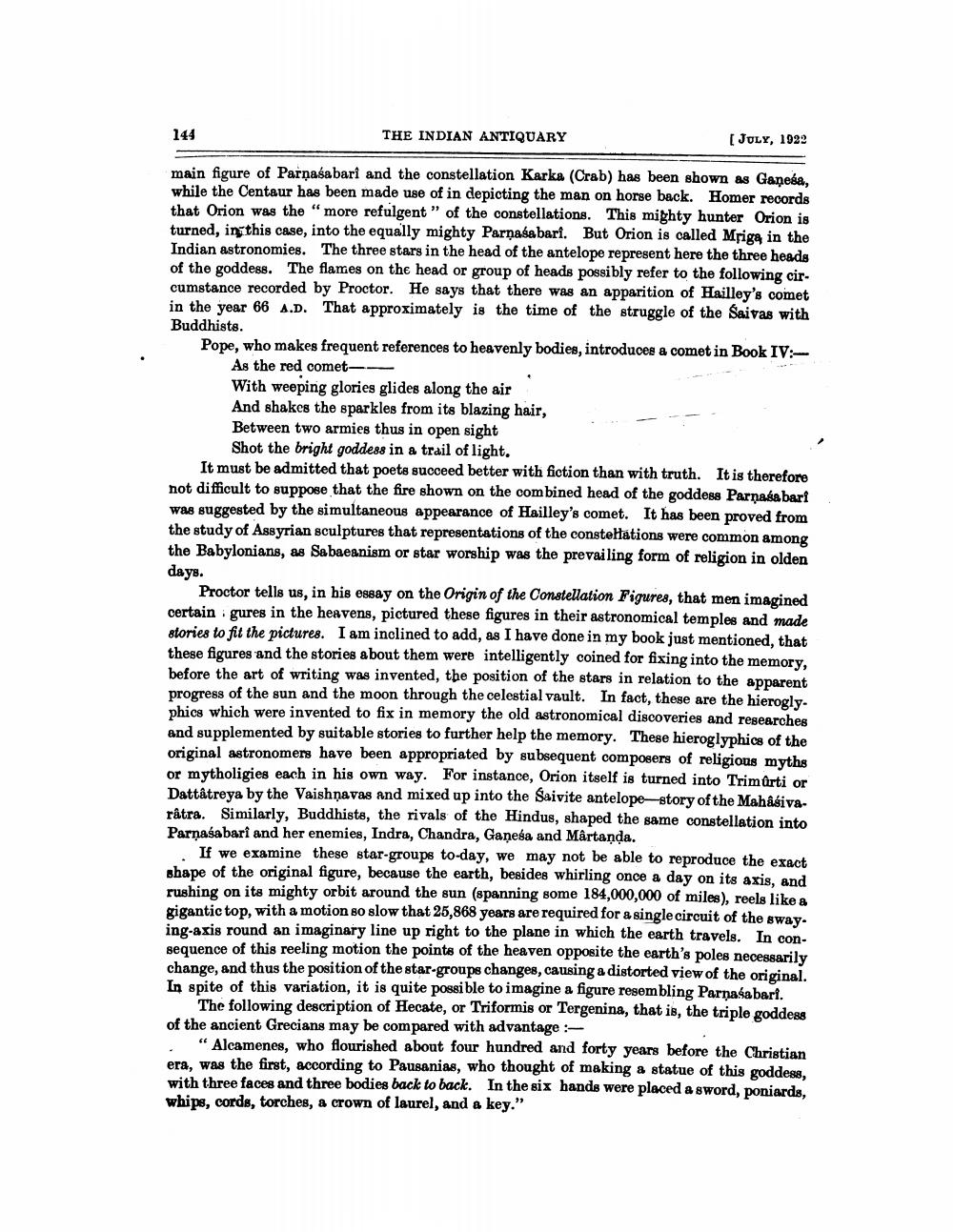________________
144
THE INDIAN ANTIQUARY
(JULY, 1022
main figure of Parnaśabari and the constellation Karka (Crab) has been shown as Ganesa, while the Centaur has been made use of in depicting the man on horse back. Homer records that Orion was the "more refulgent” of the constellations. This mighty hunter Orion is turned, in this case, into the equally mighty Parnasabari. But Orion is called Mriga in the Indian astronomies. The three stars in the head of the antelope represent here the three heads of the goddess. The flames on the head or group of heads possibly refer to the following circumstance recorded by Proctor. He says that there was an apparition of Hailley's comet in the year 66 A.D. That approximately is the time of the struggle of the Saivas with Buddhists. Pope, who makes frequent references to heavenly bodies, introduces a comet in Book IV:
As the red cometWith weeping glories glides along the air And shakes the sparkles from its blazing hair, Between two armies thus in open sight
Shot the bright goddess in a trail of light. It must be admitted that poets succeed better with fiction than with truth. It is therefore not difficult to suppose that the fire shown on the combined head of the goddess Parnasa bari was suggested by the simultaneous appearance of Hailley's comet. It has been proved from the study of Assyrian sculptures that representations of the constellations were common among the Babylonians, as Sabaeanism or star worship was the prevailing form of religion in olden days.
Proctor tells us, in his essay on the Origin of the Constellation Figures, that men imagined certain gures in the heavens, pictured these figures in their astronomical temples and made stories to fit the pictures. I am inclined to add, as I have done in my book just mentioned, that these figures and the stories about them were intelligently coined for fixing into the memory, before the art of writing was invented, the position of the stars in relation to the apparent progress of the sun and the moon through the celestial vault. In fact, these are the hieroglyphics which were invented to fix in memory the old astronomical discoveries and researches and supplemented by suitable stories to further help the memory. These hieroglyphics of the original astronomers have been appropriated by subsequent composers of religious myths or mytholigies each in his own way. For instance, Orion itself is turned into Trimôrti or Dattatreya by the Vaishnavas and mixed up into the Saivite antelope story of the Mahâśivarâtra. Similarly, Buddhists, the rivals of the Hindus, shaped the same constellation into Parnaśabari and her enemies, Indra, Chandra, Ganesa and Mártanda
If we examine these star-groups to-day, we may not be able to reproduce the exact shape of the original figure, because the earth, besides whirling once a day on its axis, and rushing on its mighty orbit around the sun (spanning some 184,000,000 of miles), reels like a gigantic top, with a motion so slow that 25,868 years are required for a single circuit of the sway. ing-axis round an imaginary line up right to the plane in which the earth travels. In consequence of this reeling motion the points of the heaven opposite the earth's poles necessarily change, and thus the position of the star-groups changes, causing a distorted view of the original. In spite of this variation, it is quite possible to imagine a figure resembling Parnasabari.
The following description of Hecate, or Triformis or Tergenina, that is, the triple goddess of the ancient Grecians may be compared with advantage :
Alcamenes, who flourished about four hundred and forty years before the Christian era, was the first, according to Pausanias, who thought of making & statue of this goddess, with three faces and three bodies back to back. In the six hands were placed a sword, poniards, whips, corde, torches, a crown of laurel, and a key."




